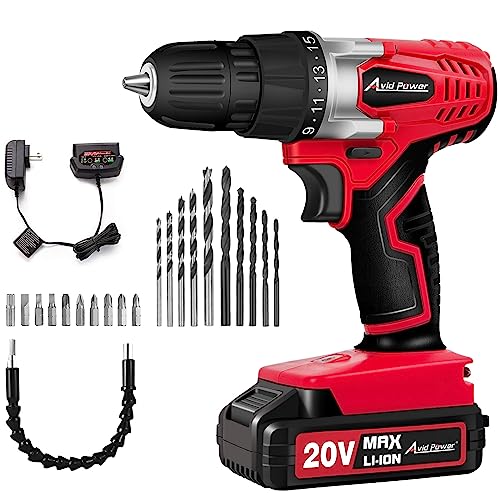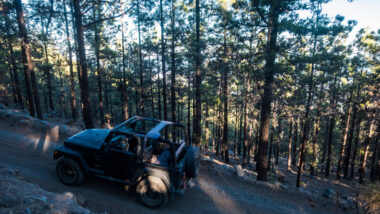Table of Contents Show
If hunkering down for the winter in your rig, RV skirting is a must if battling extreme cold temperatures.
You want to do everything possible to give you and your RV the best chance of staying warm. If considering your options for protecting your RV this winter, keep reading.
Today, we’re sharing everything you need to know about RV skirting and how it can help you and your RV stay nice and toasty this winter. Let’s get started.
What Is RV Skirting?
RV skirting surrounds the bottom of an RV to serve as a wind block and protects your rig from frigid temperatures.
Because RVs often sit a couple of feet off the ground, the cold wind can blow under them, which makes it challenging to keep the inside of an RV warm.
It can also lead to burst pipes and other damage. Several types of RV skirting exist, but they all accomplish the same goal. If your RV doesn’t spend much time in freezing temperatures, investing in RV skirting might be unnecessary.
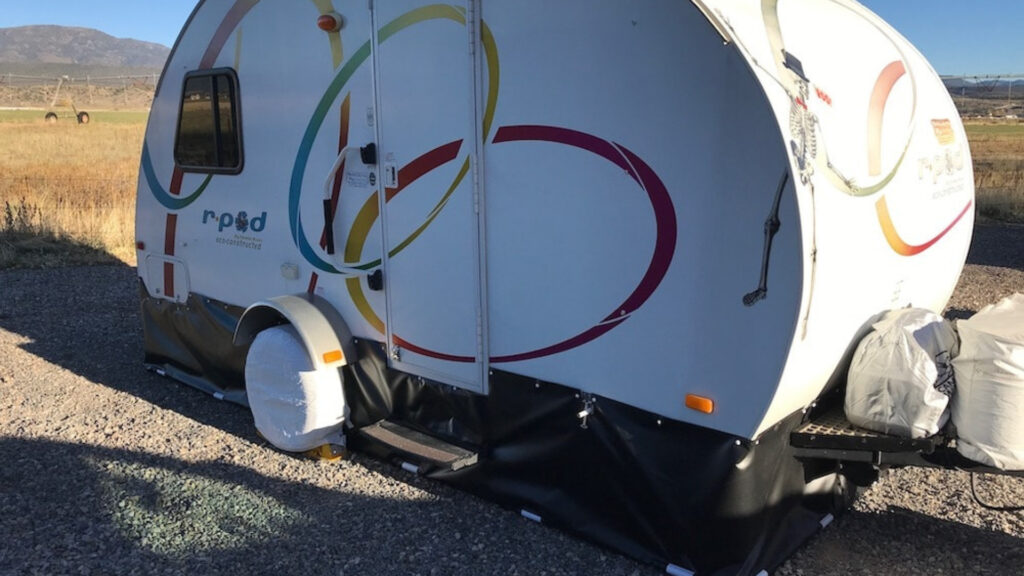
Pros of RV Skirting
If planning to use your RV through a cold winter season, you have many reasons to invest in RV skirting.
First, it keeps the extreme cold and wind from reaching the sensitive components under your RV. Manufacturers typically poorly insulate the underbelly of your rig where water and plumbing lines live.
Extreme cold can cause these lines to freeze, resulting in the inability to access water and potential damage to your plumbing system.
Second, extremely cold winds getting under your RV can cause the floor of your rig to get cold. We’ve seen RVers post pictures where the temperatures of their floors were hovering in the 40s.
Keeping the cold wind away from the underside of your rig helps avoid walking on what feels like a block of ice. You’ll also give your RV’s furnace a chance to keep you and your rig warm.
If you use propane to heat your RV, you will go through a lot of it when the temperatures drop.
Having RV skirting helps to avoid replacing the warm air in your RV with the cold air under your rig. In some extreme cases, we’ve blown through 30-pound propane tanks in a couple of days while trying to stay warm in our RV.
Cons of RV Skirting
While you have many things to love about RV skirting, it’s not perfect. First, RV skirting can cost a pretty penny. Depending on which RV skirting you choose, you could spend a couple of hundred to a few thousand dollars.
You can find custom-made and DIY options available depending on your preference and bank account.
Another con of RV skirting is that you’ll need to figure out where you’ll store it when not in use. If traveling the country full-time, it can be a pain to haul it around with you when you don’t use it for several months. If you find a place to store it, you’ll need to make sure you return to that location each winter.
Lastly, installing it can be a rather labor-intensive task. The materials can be heavy and difficult for some people to handle and install without getting hurt or damaging something.
Even if you’re up for the labor, it can take a lot of time to install correctly to ensure no wind or critters can get under it.
At What Temperature Should You Skirt Your RV?
It’s better to skirt your RV early than to wait for the freezing temperatures to arrive to do the task. If setting up camp for the winter, we recommend putting it on once the temperatures start hitting the 30s and 40s at night.
This likely means that the day temperatures remain in the 50s and 60s, which can be comfortable for outdoor work projects.
You want to feel comfortable enough not to rush to get the project done so you can get inside to get warm. Take your time and do it right.
Speeding through a project like this can result in a less-than-stellar installation, which could cause issues once the frigid temperatures arrive. You want the most benefit from your skirting, so save yourself the hassle and do it right.
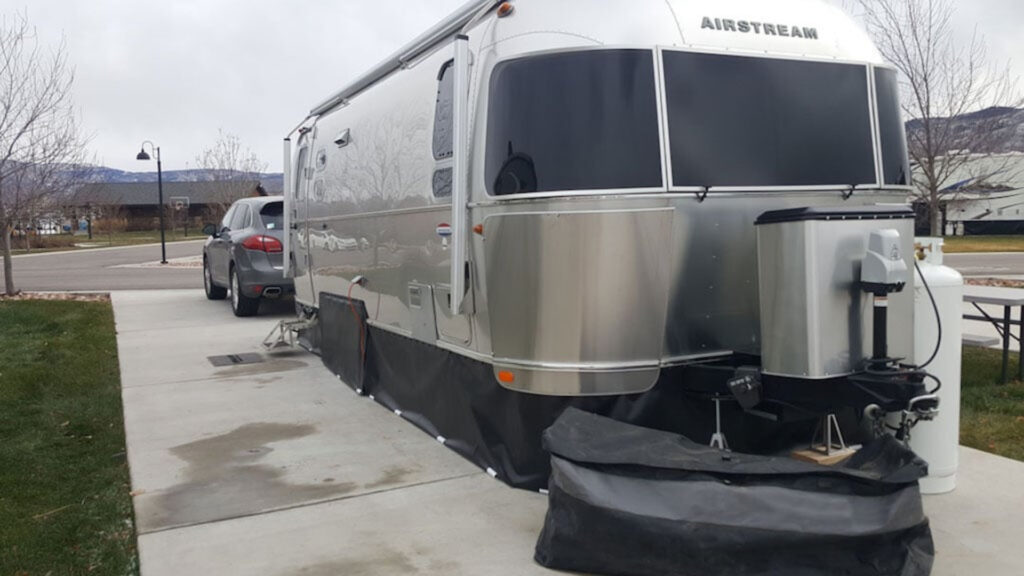
Should You Skirt Your RV in the Summer?
Some RVers will skirt their RVs in the summer. Skirting your RV in the summer can help keep the interior of your RV cooler, lower energy costs, and give your air conditioner a little help.
Controlling the climate inside your RV can be challenging in winter and summer.
However, summer is typically the prime camping season for many RVers. If you plan to tow your RV from one campsite to another, skirting your RV might not be worth it.
You’ll have to take down your skirting each time you want to move your RV, which can be time-consuming and labor-intensive. You typically only want to go through the hassle when sitting stationary for extended periods.
Does Skirting Need to Be Insulated?
RV skirting aims to prevent cold air from flowing under your rig and keep the warm air inside. Any RV skirting that can reduce the airflow under your rig will do the job. Does insulation help?
Yes, but it’s typically only necessary if you plan to spend considerable amounts of time where temperatures sit 15 or more degrees below freezing for most of the season.
If that’s not the case for you, you’ll likely spend more money than necessary on your RV skirting.
Keep in Mind: RV insulation is essential for having a comfortable RV experience! Take a look at our Ultimate Guide for Keeping Comfortable (and Saving Money) on your RV insulation.
RV Skirting Options
If shopping for RV skirting, here are some of the best options worth considering.
You must look at all your options and find which will work for your RV and your unique situation. Let’s take a look.
Airskirts
Price: $1,800 to $3,000+
Material: Airskirts use a heavy-duty canvas with a military-grade PVC coating.
About: Inflate the Airskirts around the base of your rig. The trapped air inside the insulators significantly reduces the airflow under your rig. This keeps hot and cold air from getting underneath and makes it easy to control the climate inside your rig.
Because they inflate, they make for easy and compact storage when not in use. It’s not the cheapest RV skirting option, but it does a fantastic job. And you can easily set it up and take it down.
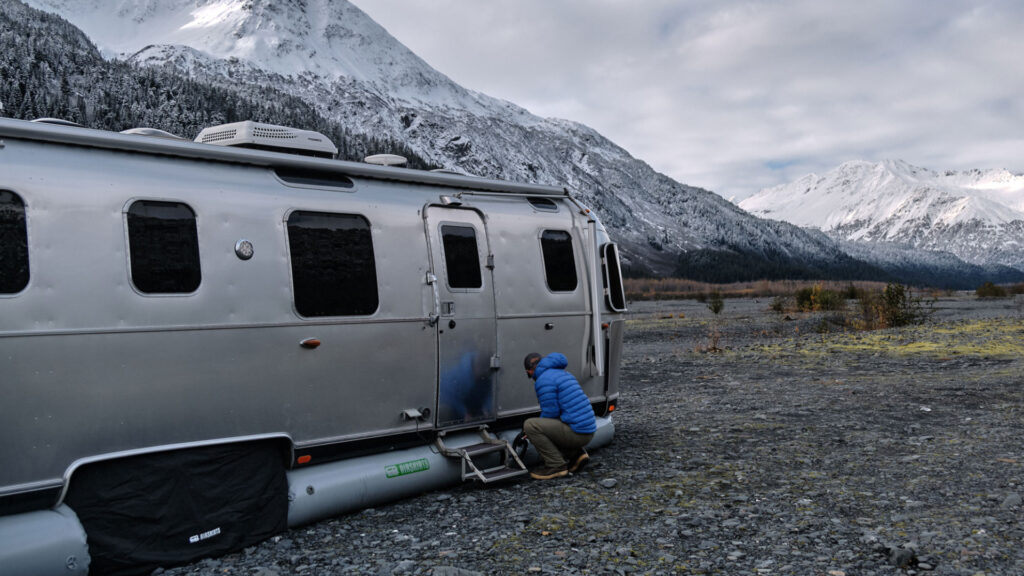
The RV Skirting Company
Price: $2,000 to $3,500+
Material: These RV skirts use 18-ounce vinyl-coated polyester with extremely high tensile strength. This is the same material used on flatbed trucks covering their loads on the highway.
About: The RV Skirting Company creates custom-made skirts. This helps ensure you get one made out of high-quality materials that perfectly fit your rig.
These use various pieces that zip together. The average RV using one of these skirts will require five to 11 skirting parts.
The company includes 12 extra inches of material at the bottom to accommodate different sites.
Additionally, it has a 5-inch pocket at the bottom to slide a PVC pipe in and provide additional support to hold down the skirting.
If that’s not enough, they also include nail-down straps every three inches so you can stake it down during high winds. These skirts install in as little as 20 minutes, which means you can easily use them even if not sitting stationary for months at a time.
EZ Snap
Price: $1,000+
Material: EZ Snap uses a lightweight Diamond-Weave skirting material with a -40 degree cold weather rating.
About: You can purchase an EZ Snap kit that fits any size or type of RV. Just cut the materials to fit the unique dimensions of your RV.
It uses 3M Extreme Hold technologies to avoid drilling into your rig to secure them to your RV.
You can save thousands of dollars and get the same results as custom-made options by choosing EZ Snap.
Choose one of their four colors to help match your RV and create a polished luxury look as it braves winter and summer elements. Additionally, the non-fray fabric is easy to cut and fits the unique shape of your rig.
DIY With Foam Board
Price: $25 per foam board
Material: Foam
About: If you don’t want to drop massive cash on RV skirting, you can go the DIY route by using foam boards. You can easily get foam boards at your favorite local big-box retailer.
Measure the distance between the ground and your RV, and calculate how many 4-foot by 8-foot sheets you’ll need to surround the rig.
Next, cut the sections and use a tape rated for cold weather to secure them to the bottom of your RV.
However, that tape may leave residue on your RV, so attach it to the backside of the metal RV skirting. If it does leave something behind, you won’t have to worry about seeing it on the outside.
This can become a time-consuming process, but take your time. Don’t get in so much of a hurry that you sacrifice quality.
Also, create a tight seal between the foam boards with the tape to prevent air from getting into your rig.
Keep in Mind: While RV skirting is something you can DIY, should you DIY your 5th Wheel Hitch Installation or Bring in a Professional? Click the link to find out!
- White Foam Board, Lightweight But Strong And Rigid Surface
- 3/16" Sheets Making It Easy To Cut
- Aluminum foil tape engineered and designed for seaming, patching, and sealing
- Enhances appearance and maintains vapor barrier integrity
DIY with Vinyl
Price: $800 in material
Material: Vinyl
About: While you can spend thousands on custom-made vinyl RV skirting, you can do this project for around $800 or so, depending on the size of your rig.
You’ll first want to measure the length of your RV’s exterior, including the height from the ground to your skirting. This will help you know how much skirting material you’ll need.
Aside from the vinyl material, you’ll need to gather a few additional tools and items such as snaps, a Press-N-Snap tool, vinyl cement, velcro, PVC pipe, PVC clamps, RV Butyl tape, a drill, tape measure, and a silver sharpie.
Once you’ve gathered all of the supplies, you can start working towards creating your DIY skirting.
You’ll first need to install the snaps along your RV by screwing them into the side of your camper. Next, use the RV butyl tape on the back of the snaps when installing to avoid any potential leaks from the new holes in the side of your rig.
- Sold by the Kit
- Snaps sold separately
- ✌️ Would you like to seal anything securely? Do you want to stop worrying about the quality of butyl tape? Forget...
- ✌️ [GOOD ON ANY SURFACE & FOR ANY USE] – RV BUTYL TAPE WORKS ON PLASTIC, GLASS, METAL, etc. Perfect Butyl Tape RV...
This can be a time-consuming process. To create a professional look, you want all the snaps to line up and be at the same height and spacing.
Once you’ve installed all of the snaps on your RV, you can start using the Press-N-Snap tool to install the other side of the snaps onto the vinyl. Finally, you’ll want to fold over the top layer of the vinyl a couple of inches.
- Bonds in Tough Conditions – You can apply our American made vinyl adhesive in temperatures ranging from 35 to 95...
- Sturdy and Flexible – Our highly regarded HH-66 Vinyl Cement sets the industry standard for vinyl material repair,...
But ensure you have several inches of extra material to reach the ground to adjust for any potential future uses.
You can then stretch the vinyl material to the next snap and use the silver Sharpie to mark where you should install the next one. Repeat this process as you move around your rig.
- FOR EXTREME WEATHER CONDITIONS - Outdoor VELCRO Brand fasteners have water and UV resistance to keep double sided...
- PROFESSIONAL GRADE FASTENERS - Industrial strength VELCRO Brand hook and loop tape provides strong holding power;...
- ✅Furniture Grade PVC Pipe - Ideal choice for your DIY PVC structures & projects. PVC Greenhouse, PVC Sheds, PVC...
- ✅UV Resistant - Infused with UV inhibitors to allow the pipe to be used in the sun. Will not crack, change color or...
Pull the vinyl tight when marking the location for the next snap. Finally, use the PVC clamps and PVC pipe to hold the bottom of your RV skirting at the base.
- Package Includes: you will receive 32 pieces greenhouse clamps; Enough quantity to meet your daily use and greenhouse...
- Proper Size: the size of this clamp is approx. 2.4 inch in length and fits greenhouse frame tubing with an outside...
- [Real-time Battery Level] AVID POWER 20V 1.5Ah Lithium-ion battery pack comes with a real-time battery level display....
- [15+1 Position Clutch] : 15+1 torque (280 In-lbs) settings provide precise control for driving in/out screws to prevent...
Is RV Skirting Worth It?
If you plan to spend a significant amount of time in your RV in locations that experience freezing temperatures, RV skirting can be a lifesaver.
You can save on propane by protecting your RV from the cold winds.
Depending on which route you go and how often you’ll stay in extreme temperatures, RV skirting can help you save a lot of money over the long haul.
However, it might not seem worth it if you plan to head south for the winter or spend your time in cooler climate locations.
Are you considering RV skirting for your rig?
Last update on 2024-12-26 / Affiliate links / Images from Amazon Product Advertising API




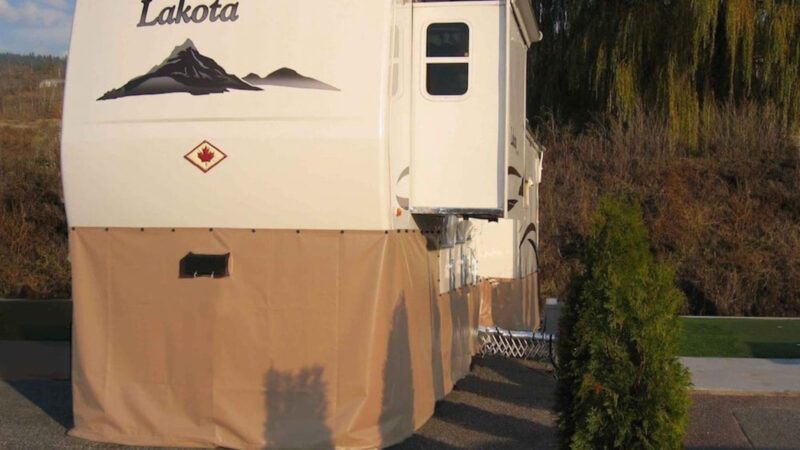






![letsFix 1/2' PVC Pipe, DIY PVC Projects for the Home, Garden, Greenhouse, Farm and Workshop, Sch. 40 Furniture Grade, White [40' x 10 Pack]](https://m.media-amazon.com/images/I/41KhGcfSy5L.jpg)

